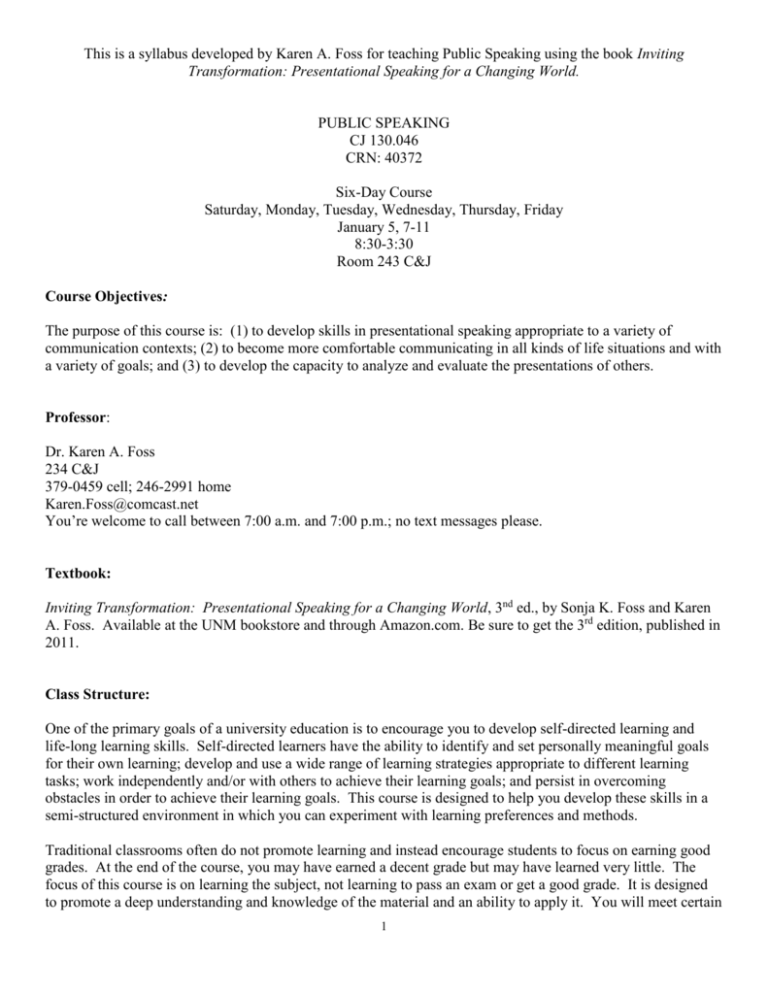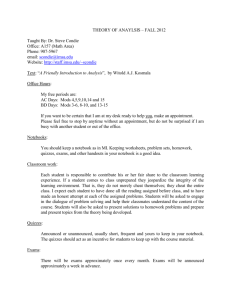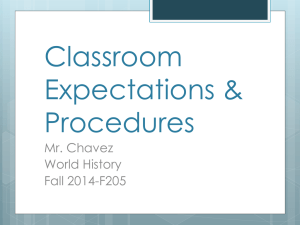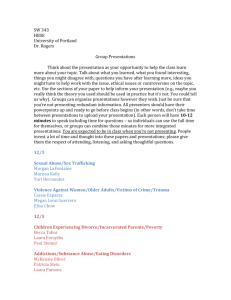Presentational Speaking (Week-Long Course)
advertisement

This is a syllabus developed by Karen A. Foss for teaching Public Speaking using the book Inviting Transformation: Presentational Speaking for a Changing World. PUBLIC SPEAKING CJ 130.046 CRN: 40372 Six-Day Course Saturday, Monday, Tuesday, Wednesday, Thursday, Friday January 5, 7-11 8:30-3:30 Room 243 C&J Course Objectives: The purpose of this course is: (1) to develop skills in presentational speaking appropriate to a variety of communication contexts; (2) to become more comfortable communicating in all kinds of life situations and with a variety of goals; and (3) to develop the capacity to analyze and evaluate the presentations of others. Professor: Dr. Karen A. Foss 234 C&J 379-0459 cell; 246-2991 home Karen.Foss@comcast.net You’re welcome to call between 7:00 a.m. and 7:00 p.m.; no text messages please. Textbook: Inviting Transformation: Presentational Speaking for a Changing World, 3nd ed., by Sonja K. Foss and Karen A. Foss. Available at the UNM bookstore and through Amazon.com. Be sure to get the 3rd edition, published in 2011. Class Structure: One of the primary goals of a university education is to encourage you to develop self-directed learning and life-long learning skills. Self-directed learners have the ability to identify and set personally meaningful goals for their own learning; develop and use a wide range of learning strategies appropriate to different learning tasks; work independently and/or with others to achieve their learning goals; and persist in overcoming obstacles in order to achieve their learning goals. This course is designed to help you develop these skills in a semi-structured environment in which you can experiment with learning preferences and methods. Traditional classrooms often do not promote learning and instead encourage students to focus on earning good grades. At the end of the course, you may have earned a decent grade but may have learned very little. The focus of this course is on learning the subject, not learning to pass an exam or get a good grade. It is designed to promote a deep understanding and knowledge of the material and an ability to apply it. You will meet certain 1 standards in terms of the application of knowledge, but you will also choose the grade you want and ways to learn the material that work best for you. You will also set your own schedule for accomplishing this work. What this means in practice, then, is that you will select the grade you want in the course and complete the assignments necessary to fulfill that grade. You will come to class only when you have something to do—take a quiz, give a presentation, or get help on an upcoming presentation. When you have earned the grade you wish to receive for the class, you are done with the course. The format of the course also means that you need to take charge of your own time and schedule and plan accordingly. You do not need to tell me when you are coming and going, and I will not take attendance, but don’t wait until the last minute in case you get sick, something comes up, or you need to redo a quiz or presentation. I am available every class session as a resource to answer questions about ideas and concepts you don’t understand, to dispense quizzes when you are ready to take them, to help you develop your presentations, and to listen to presentations. My main goal is that you learn the material and become a better and more confident speaker. Please utilize me to help you achieve the goals you have set for yourself. “Doing” the Course 1. Arrive on time Saturday morning at 8:30. If you are not present Saturday from 8:30-1:30, you will be dropped from the course. This is the time in which crucial information about the course will be given; it is the only time during the week in which you are absolutely required to be in attendance. 2. Select the grade you want to try to earn for the course from the options below. Assignments are explained more fully in the next section. To receive a grade of A, you must satisfactorily: Give the speech of introduction. Turn in the list of presentations you will be giving by the end of class on Saturday. Pass quizzes on all 6 units of textbook material. A passing grade on the quizzes is a score of 6 out of 8 points. Give 4 major presentations on time (receiving at least 20 points on each) and turn in a speaking plan for each on the day you speak (earning a score of + or √). Give 1 impromptu presentation. Contribute to class learning as an audience member and presenter by completing one major presentation and at least one quiz by the end of Tuesday. Write a self-reflection paper (earning a score of + or √) and submit it by noon the Monday following the end of the class. To receive a grade of A-, you must satisfactorily: Give the speech of introduction. Turn in the list of presentations you will be giving by the end of class on Saturday. Pass quizzes on all 6 units of textbook material. A passing grade on the quizzes is a score of 6 out of 8 points. Give 3 major presentations on time (receiving at least 20 points on each) and turn in a speaking plan for each on the day you speak (earning a score of + or √). Give 1 impromptu presentation. Contribute to class learning as an audience member and presenter by completing one major presentation and at least one quiz by the end of Tuesday. 2 Write a self-reflection paper (earning a score of + or √) and submit it by noon the Monday following the end of the class. To receive a grade of B, you must satisfactorily: Give the speech of introduction. Turn in the list of presentations you will be giving by the end of class on Saturday. Pass quizzes on 5 units of textbook material. A passing grade on the quizzes is a score of 6 out of 8 points. Give 3 major presentations on time (receiving at least 20 points on each) and turn in a speaking plan for each on the day you speak (earning a score of + or √). Give 1 impromptu presentation or write a self-reflection paper (earning a score of + or √) and submit it by noon the Monday following the end of class. Contribute to class learning as an audience member and presenter by completing one major presentation and at least one quiz by the end of Wednesday. To receive a grade of B-, you must satisfactorily: Give the speech of introduction. Turn in the list of presentations you will be giving by the end of class on Saturday. Pass quizzes on 5 units of textbook material. A passing grade on the quizzes is a score of 6 out of 8 points. Give 2 major presentations on time (receiving at least 20 points on each) and turn in a speaking plan for each on the day you speak (earning a score of + or √). Give 1 impromptu presentation or write a self-reflection paper (earning a score of + or √) and submit it by noon the Monday following the end of class. Contribute to class learning as an audience member and presenter by completing one major presentation and at least one quiz by the end of Wednesday. To receive a grade of C, you must satisfactorily: Give the speech of introduction. Turn in the list of presentations you will be giving by the end of class on Saturday. Pass quizzes on 4 units of textbook material. A passing grade on the quizzes is a score of 6 out of 8 points. Give 2 major presentations on time (receiving at least 20 points on each) and turn in a speaking plan for each on the day you speak (earning a score of + or √). Give 1 impromptu presentation or write a self-reflection paper and submit it by noon the Monday following the end of the class. (If you complete both of these assignments, you will receive a C+ in the course). Complete one major presentation and at least one quiz by the end of Thursday. PLEASE NOTE: For this class to count toward UNM general education requirements, you must pass it with a grade of C (a C- won’t do). To receive a grade of D, you must satisfactorily: Give the speech of introduction. Turn in the list of presentations you will be giving by the end of class on Saturday. Pass quizzes on 3 sections of material in the text. A passing grade on the quizzes is a score of 6 out of 8 points. Give 1 major presentation on time (receiving at least 20 points on it) and turn in a speaking plan for it on the day you speak (earning a score of + or √). 3 Give 1 impromptu presentation or write a self-reflection paper and submit it by noon the Monday following the end of the class. (If you complete both assignments, you will receive a grade of D+ in the course). PLEASE MAKE SURE YOU REMAIN AWARE OF ALL OF THE REQUIREMENTS FOR THE GRADE YOU WISH TO EARN. 3. Skim the textbook, concentrating in particular on Chapter 2 about interactional goals. 4. Select your career/life orientation from which all of your major presentations will be given. List the major presentations (between 1 and 4) you plan to give during the course, specifying the career/orientation that will be the context for the presentations, the audience for each presentation, and the interactional goal for each. You may choose to do two different career goals or one career goal and one hobby that could be a life focus. This summary is designed to serve as a check on your presentations before you give them. It does not need to be typed. Due on Saturday, the first day of class, before you leave for the day. 5. Plan a speech of introduction about you and the career/life orientation from which you will speak. In this presentation, you will give us some background about yourself and discuss the profession you plan to enter/in which you presently are employed or the life route you are engaged in or plan to take. Every life path—whether a paying job, a hobby, activism, or parenting, for example—involves communicating and giving presentations. This presentation is designed to get you thinking about the communication opportunities of your chosen life’s work and to give the rest of your class members the context from which you will be speaking for the week. The presentation should be 2-4 minutes in length. It will be given on Saturday. 6. Map out a timeline for how to spend the remaining days of the course. After the first day of class, you are free to come and go as you please. If you are planning to come in any time after noon, please call my cell phone, and let me know you are on your way. If everyone has gone for the day, I will leave, too, so just let me know to expect you, and I’ll stay. 7. Begin reading the book and taking notes using the study guide attached to this syllabus. You may take notes either on the computer or in longhand. If you have questions about concepts discussed in the book, feel free to ask me during class sessions or via e-mail. If you are not going to complete all 6 units, you can choose the units you wish to cover. 8. Take quizzes on the material in the book. Whenever you are ready to take a quiz, let me know. The quizzes are short-answer quizzes that ask you to apply concepts from each unit. You may use your study guide, with the notes you have taken, during the quiz, but you may not use the textbook. You must get 6 out of 8 points correct in order to proceed to the next unit. If you do not earn 6 points on a quiz, you can study the questions you missed and retake the quiz either that same day or another day. 9. Prepare 1, 2, 3, or 4 major presentations (depending on the grade you want to earn). You can give these at 9:00 any morning, Monday through Friday. If you plan to give a speech on any given day, you must be there at 9:00 to sign in and be a member of the audience for the other speakers. You will not be able to give speeches except in the morning. The presentations will be of the type you will be likely to give in your chosen life’s work. You can use two different contexts if you want for your presentations if you are interested in two different careers, for example, or have a hobby and a career you would like to talk about. They should vary, as much as possible, by 4 interactional goal: asserting individuality, building community, articulating a perspective, seeking adherence, and discovering knowledge and belief. If you would like to try the goal of discovering knowledge and belief, please do not do so until your final speech because of time constraints, and even then, the “discovery” portion will need to be a very small segment of your speech. Some sample scenarios, with interactional goals, for four possible presentations follow. If you plan to be a high-school teacher and basketball coach, for example, your presentations might include: (1) a pep talk to the basketball team (building community) (2) leading a discussion on Shakespeare with a class (discovering knowledge and belief; articulating a perspective) (3) speaking to a community boosters’ group about the current status of the team and asking for their support (seeking adherence, articulating a perspective, building community) (4) discussing with members of the basketball team the strategy to use in an upcoming game (discovering knowledge and belief) If you plan to work in environmental advocacy, your presentations might include: (1) encouraging university students to join an environmental organization (seeking adherence) (2) introducing yourself to staff members as the new director of an environmental organization (asserting individuality) (3) a staff meeting at which there are new staff members (building community) (4) testifying before Congress on an environmental issue (articulating a perspective, seeking adherence) If you plan to be an administrator of a public agency or private business, your presentations might include: (1) a talk to a community organization such as the Rotary Club, offering an overview of what your organization does (articulating a perspective) (2) a presentation introducing yourself—a new manager--to the staff of an organization (asserting individuality) (3) a sales presentation to a potential customer (seeking adherence) (4) a discussion with your employees about how to solve a particular problem (discover knowledge and belief) If you are concentrating on parenting as your life’s work, your presentations might include: (1) giving the birds and bees talk to your son or daughter (articulating a perspective) (2) a presentation to the PTA about a change in regulation that you support (seeking adherence) (3) a talk to a Girl Scout troop on a campout where factions have evolved among the girls (creating community) (4) a talk with your child about an incident at school that they are reluctant to discuss (discover knowledge and belief) Presentations will vary by time: Presentation #1: 4-5 minutes Presentation #2: 5-6 minutes Presentation #3: 6-7 minutes Presentation #4: 7-8 minutes (If you wish, you may combine your last two presentations in a longer talk of 10-12 minutes). 10. Turn in a speaking plan for each presentation as you get up to speak. A speaking plan is a way of making sure you have thought through your choices for your presentation. A speaking plan includes a discussion of: (1) audience; (2) setting; (3) interactional goal(s); (4) commitment statement; (5) organizational pattern; (6) major ideas; (7) major forms of elaboration; (8) type of introduction; (9) type of conclusion; (10) transitions; and (11) strengths and weaknesses of delivery. See Chapter 10 for more detail about and samples of speaking plans. You 5 will receive a score of +, √, or – on your speaking plans. If you receive a minus, you will need to redo it in order to have it count toward your final grade. Speaking plans are described and models are provided in Chapter 10. 11. Come to class ready to give an impromptu presentation. For this presentation, I will give you a question that you might be asked in real life, given your chosen life’s work. If you are planning to be an architect, for example, I might give you the following scenario: “At a family reunion, an uncle you haven’t seen for a while finds out you’re planning to be an architect. He says, “I’ve been hearing a lot about ‘green’ buildings. Can you explain what that means?” You will have about 30 seconds of time to think about your answer and organize your thoughts. Your answer should be 1-2 minutes long. If you choose to give an impromptu presentation, be ready to present it on either Tuesday at 11:00 or Wednesday at 11:00. 12. Write a self-reflection paper about you as a communicator, your speaking process, and this course. Your paper should address but need not be limited to the following: the major insights about you as a communicator that you received from this class, the most important skills you learned, strengths you have as a speaker that perhaps you did not know about, aspects about your speaking you feel need further improvement, and comments about the format of the course. If you elect to do this self-reflection, it can be turned in anytime after you have completed whatever number of oral presentations you have chosen to give in the course. The last day to submit the self-reflection paper is noon on the Monday after the class concludes. Expectations: 1. With the exception of the impromptu presentation, all presentations should be delivered extemporaneously— using notes rather than memorized or read. 2. Qualified students with disabilities who need appropriate academic adjustments should notify me immediately to ensure that your needs are met. 3. Please use sex-neutral language in your speaking and writing. Since the language we speak and write leads us to perceive in certain ways, sex-neutral language will help all of us perceive women and men on equal terms, participating fully in the world. “People,” “humanity,” or “humans” are some substitutes for “man.” Instead of using the generic “he,” you can say “he or she;” alternate pronouns, using “he” in 1 paragraph and “she” in the next; or speak in the plural so you can say “they.” Please be especially aware of your use of “you guys”—it is not appropriate for most professional settings and is generally overused in all settings. Also, the construction “Me and Bobby went to the store” or “Me and Angelica are good friends” is grammatically incorrect; it should be “Bobby and I . . .” or Angelica and I.” Get out of the habit of using this construction altogether. 4. Please turn off cell phones so they do not ring or vibrate during class. You may use your phone if you have the syllabus on it and as a timer, and you may listen to music while you take notes and take quizzes. Schedule: Saturday Introduction to class; select focus for presentations; give speech of introduction at 1:00 (or whatever time works best for the size of the class); turn in list of presentations. Start working on taking notes, taking quizzes, and preparing major presentations. Monday 8:30-9:00: Takes notes on chapters and/or take quizzes 9:00: This time is set aside for you to give one of the major presentations. 6 Remaining time: Work on taking notes, taking quizzes, and preparing for your next presentation. Tuesday 8:30-9:00: Takes notes on chapters and/or take quizzes 9:00: Give presentations. 11:00: Give impromptu presentations. Remaining time: Work on taking notes, taking quizzes, and preparing for your next presentation. (If you are aiming for an A or A- in this course, you must do at least one quiz and one major presentation by the end of today.) Wednesday 8:30-9:00: Takes notes on chapters and/or take quizzes 9:00: Give presentations. 11:00: Give impromptu presentations. Remaining time: Work on taking notes, taking quizzes, and preparing for your next presentation. (If you are aiming for a B or B- in this course, you must do at least one quiz and one major presentation by the end of today.) Thursday 8:30-9:00: Takes notes on chapters and/or quizzes 9:00: Give presentations. Remaining time: Work on taking notes, taking quizzes, and preparing for your next presentation. (If you are aiming for a C in this course, you must do at least one quiz and one major presentation by the end of today.) Friday 8:30-9:00: Takes notes on chapters and/or take quizzes 9:00: Give presentations. Remaining time: Finish quizzes. Monday Noon: Self-reflection papers are due (submit via e-mail to Karen.Foss@comcast.net). Your grade will be affected if it does not arrive in my inbox on time. 7 Study Guide for Quizzes Inviting Transformation: Presentational Speaking for a Changing World 3rd edition Below are the concepts to study for each of the six quizzes in the course. Take notes on separate paper or on computer. You may use these notes but not the book for the quizzes. Quiz #1: Chapter 1 3 periods of globalization 4 ways of responding to difference 4 modes of rhetoric appreciation vs. tolerance how personal transformation can impact the external world invitational rhetoric Know 4 (of 8) assumptions of invitational rhetoric argument culture Quiz #2: Chapter 2 presentational speaking vs. public speaking rhetorical situation exigence 5 interactional goals; for each, given an example of a presentation in which that would be your primary goal assert individuality articulate a perspective build community seek adherence discover knowledge and belief steps in the facilitation process 8 Quiz #3: Chapter 3 4 external conditions to create in the speaking environment safety openness freedom value 2 ways to facilitate safety in a presentation 2 ways to facilitate openness in a presentation 2 ways to facilitate freedom in a presentation 2 ways to facilitate value in a presentation 4 components to consider when analyzing a speaking environment setting audience speaker subject resourcement steps in the process of resourcement Quiz #4: Chapters 4 and 5 Chapter 4: thesis statement distinguish a thesis statement from a topic generate a thesis statement for each of 3 of the interactional goals main ideas and their relationship to the thesis statement 4 types of speaking resources Know 3 (of 5) criteria for evaluating information found on the Internet 9 Chapter 5: framing organizational patterns (know at least 6 of the following—preferably ones new to you) alphabet category causal circle continuum elimination location metaphor motivated sequence multiple perspectives narrative narrative progression problem-solution spiral thinking things through time web Quiz #5: Chapters 6 and 7 Chapter 6: elaborating forms of elaboration (know at least 6 of the following—preferably ones new to you) audiovisual aids comparison and contrast credentials definition dreams emotions exaggeration examples explanation facts figures of speech humor myths narratives participation 10 poetry prayers proverbs puns questions quotation repetition and restatement rhythm and rhyme ritual sensory images songs statistics understatement visions Chapter 7: Importance of introductions 2 types of introduction not to use types of introductions (know 3 of the following—preferably ones new to you) narrative poem question quotation reference to speaking situation functions of conclusions ways to signal that your ending a presentation types of conclusions (know 3 of the following—preferably ones new to you) call to action narrative pledge poem quotation reference to introduction reference to speaking situation summary of basic theme summary of main ideas Quiz #6: Chapters 8 and 9 Chapter 8: why organizing a presentation is important 11 functions of transitions forms of transitions paragraphs sentences phrases or single words “in conclusion, I would like to say” Chapter 9: functions of delivery Know 4 (of 7) components of delivery mode of presentation speaking notes time limits practice bodily elements personal appearance and dress presentational aids 3 difficulties with PowerPoint software 3 effective ways to use presentational software twirks types of twirks (know 3 of the following) communication anxiety language clothing and adornment permanent physical conditions presentational aids 2 ways to handle symptoms of communication anxiety 12 Evaluation Form (20 points needed to pass; 3=outstanding; 2=good; 1=adequate) Name ________________________ Presentation # __________ Grade _____________ Interactional goal is clear and appropriate for the audience. -information provided is connected to the purpose of the presentation and the relevance to the audience is shown Commitment statement is present, clear, and appropriate. Attends to the structure and style of the presentation -organizational pattern is clear and contributes to achieving the goals of the presentation -transitions aid in moving the presentation forward Introduction and Conclusion -introduction and conclusion are strong and appropriate to goal Provides ample support, sources, examples, and details -all ideas are supported by appropriate, interesting, and effective forms of elaboration. -the support is credible, accessible, and appropriate to the audience Smooth, cohesive flow -flow of presentation is smooth with good transitions between sections Language is appropriate to the audience -Linguistic choices are considered and managed--“you guys,” sexist language, etc. are absent/kept to a minimum -Presentation is essentially free of grammatical and pronunciation errors Attends to delivery elements -all aspects of the delivery are considered, evaluated and the best strategies for the situation and audience are used -visual aids are appropriate, purposeful, visible, and aesthetic -twirks are handled effectively Is invitational in approach, -takes into consideration perspectives of the audience and the kind of environment being created -offers an invitation to the audience to see the world from a particular perspective Adheres to time limit: The presentation is within 30 seconds (either short or long) of the time limit. 13





